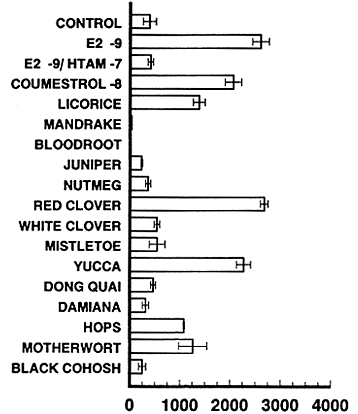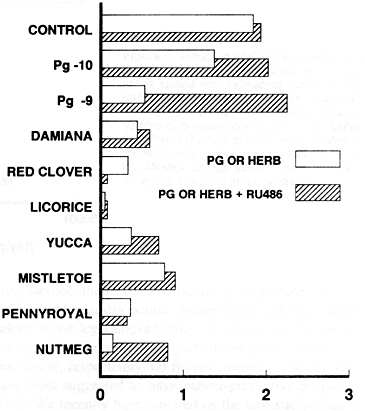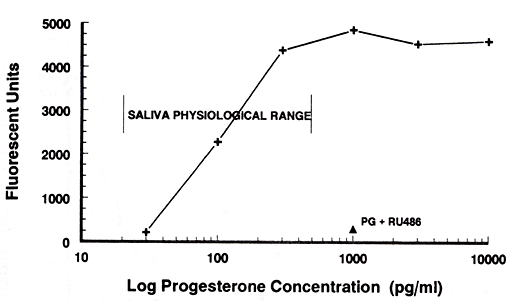|
Fifth Dimension Catalog Contact Us |
|

|
Estrogen and Progestin Bioactivity of Foods, Herbs, and Spices (44247) Figures and Tables |
|
Table 1 |
|||||
|
Acacia (Acacia senegal), Agrimony (Agrimonia eupatoria), Unicorn root (Aletris farinosa), Alfalfa (Medicago sativa), Aloe (Aloe vera), Anise (Pimpinella anisum), Asparagus (Asparagus officinalis), Astragalus (Astragalus membranaceus) |
Barberry (Berberis vulgaris), Bay leaf (Laurus nobilis), Bayberry (Myrica cerifera), Black Cohosh (Cimicifuga racemosa), Black Current (Ribes nigrum), Blessed Thistle (Cnicus benedictus), Bloodroot (Sanguinaria canadensis), Blue Cohosh (Caulophyllum thalictroides), Blue Flag (Iris versicolor), Borage (Borago officinalis), Bryony root (Bryonia alba), Burdock root (Arctium lappa) |
Calamus root (Acorus calamus), Calendula (Calendula officinalis), Caraway seed (Carum carvi), Cascara Sagrada (Rhamnus purshiana), Catnip (Nepeta cataria), Cayenne (Capsicum annum), Celandine (Chelidonium majus), Chamomile (Chamaemelum nobile), Chaste-tree (Vitex agnus-castus), Cherry, wild (Prunus avium), Chickweed (Stellaria media), Cilantro (Coriandrum sativum), Cloves (Syzygium aromaticum), Crampbark (Viburnum opulus), Cumin (Cuminum cyminum) |
Damiana (Turnera diffusa), Devil's Club (Oplopanax horridum), Dock (Rumex obtusifolius), Dong quai (Angelica sinensis) |
Echinacea (Echinacea purpurea), Endive (Chicorium endivia), Ephedra-Ma Huang (Ephedra distachya), Equisetum (Equisetum arvense), Evening Primrose (Oenothera biennis), Eyebright (Euphrasia officinalis) |
False Unicorn (Chamaelirium luteum), Fennugreek (Trigonella foenumgraecum), Fennel (Foeniculum vulgate), Flaxseed (Linum usitatissimum) |
|
Garlic (Allium sativum), Gelsium (Gelsium sempervirens), Gentian root (Gentiana macrophylla), Ginger root (Zingiber officinale), Ginko (Ginko bilboa), Ginseng (Panax ginseng), Ginseng, Wild Siberian (Eleutherococcus senticosus), Goldenseal (Hydrastis canadensis), Gotu Kola (Centella asiatica), Gravel root (Eupatorium purpureum) |
Henna-Red (Lawsonia inermis), Hops (Humulus lupulus), Horehound (Marrubium vulgare), Hyssop (Hyssopus officinalis) |
Ironwood bark (Ostrya virginiana) |
Juniper berry (Juniperus communis) |
Kavakava root (Piper methysticum) |
Lavender (Lavandula angustifolia), Lemon Grass (Cymbopogon citratus), Licorice (Glycyrrhiza glabra), Lobelia (Lobelia chinensis), Lovage root (Levisticum officinale) |
|
Nettle (Urtica dioica), Nutmeg (Myristica fragrans) |
Oatstraw (Avena sativa), Ocatillo (Fouquieria splendens), Onion (Allium cepa), Oregano (Origanum vulgare), Oregon Grape seed (Berberis aquifolium Pursh.) |
Passion fruit (Passiflora incarnata), Pau d'Arco (Tabebuia spp.), Pennyroyal (Mentha pulegium), Peony root (Paeonia officinalis), Periwinkle (Vinca), Pipsisewa (Chimaphila umbellata), Pokeweed root (Phytolacca americana), Pomegranate (Punica granatum), Poppy seed (Papaver somniferum) |
Red Clover (Trifolium pratense), Red Raspberry (Rubus idaeus), Red Root (Ceanothus americanus), Rosemary (Rosmarinus officinalis), Rue (Ruta graveolens) |
Saffron (Crocus sativus), Sage (Salvia officinalis), Sarsaparilla (Smilax), Sassafras (Sassafras albidum), Savory (Satureja hortensis), Saw Palmetto (Serenoa repens), Senna (Senna), Sesame seed (Sesamum indicum) Shavegrass (Equisetum arvense) sheep Sorrel (Rumex acetosella), Shephard's Purse (Capsella bursa-pastoris), Skullcap (Scutellaria lateriflora), Slippery Elm bark (Ulmus rubra), Smallage (Apium graveolens), Solomon's Seal (Polygonatum officinale), St. John's Wort (Hypericum perforatum), Strawberry leaf (Fragaria vesca), Sumac (Rhus glabra) |
Tansy (Tanacetum vulgate), Thyme (Thymus vulgaris), Turmeric (Curcuma longa) |
|
Uva Ursi (Arctostaphylos uva-ursi) |
Valerian (Valeriana officinalis), Vervain (Verbena officinalis), Vitex-chaste tree (Agnus canthus) |
Wild Pansy (Viola tricolor), Wild Yam (Dioscorea villosa), Wormwood (Artemisia absinthium) |
Yarrow (Achillea millefolium), Yellow dock (Rumex crispus), Yerba Mansa (Anemopsis californica), Yucca (Yucca Spp.) |
||
|
|
|||||||||||||||||||||||||||||||||||||||||||||||||||||||||||||||||||||||||||||||||||||||||
|
Figure 1 Effects of ER-binding herb extracts on growth of ER (+) breast cancer cells in vitro. Cells were grown in 96-well plates for 9 days in absence (control) or presence of estradiol, estradiol plus hydroxytamoxifen, coumestrol, or herbal extracts (1/500 dilution). Growth was assessed by measuring protein directly in the wells as indicated in the Methods. |
Figure 2 Effects of ER-binding herb extracts on growth of ER (-) breast cancer cells in vitro. Cells were grown in 96-well plates for 7 days in absence (control) or presence of estradiol, estradiol plus hydroxytamoxifen, coumestrol, or herbal extracts (1/500 dilution). Growth was assessed by measuring protein directly in the wells as indicated in the Methods. |
|
Figure 3 - nmoles PNP formed/min / µg protein |
Figure 4 - fmoles Estrogen Receptor/ µg DNA |
|
Figure 3 Induction of alkaline phosphatase by progesterone plus RU486, and PR binding herbal extracts, with and without progesterone. Near confluent cells in 96-well plates were exposed to increasing doses of progesterone, 10-9M progesterone plus 10-7MRU486 or 1/500 dilution of herbal extracts (as indicated) without or with 10-9M progesterone. After 48 hr, cells were fixed and alkaline phosphatase measured directly in the plate as indicated in Methods |
Figure4 Down regulation of ER by progesterone and herbal extracts in the absence and presence of RU486. Near confluent cells in 24-well plates were exposed to progesterone and herbal extracts, without or with 10-9M RU486. After 48 hr. ER wa measured directly in the plate by incubating cells with 2nM [125l]-estradiol. Following incubation, the cells were removed from the plate with trypsin and the radioactive binding of [125l]-estradiol was meansured in nuclei as decribed previously. (11) |
|
Figure 5 - Log Progesterone Concentration (pg/ml)
|
Figure5 - Induction of alkaline phosphatase in T47D breast cancer cells with extracts of saliva spiked with increasing doses of progesterone. Pooled saliva was charcoal treeated then spiked with increasing concentrations of progesterone as indicated. Saliva was then extracted in DEE, reconstituted in growth media and then incubated with cells for 48 hr. Alkaline phosphastase was then determined as indicated in the Methods |
|
Figure 6 - PR Binding (pg/ml Pg Equivalents)
|
Figure6 - Induction of alkaline phosphatase in T47D breast cancer cells with extracts of saliva from premenomausal women and women taking progesterone, MPA, and wild-yam (diosgenin-containing) herbs. Saliva was processed as described in Figure 5 and incubated with cells for 48 hr. Alkaline phosphastase was measured as described above. |
|
Figure 7 - Hours Post SoyMilk Ingestion
|
Figure 7 Phytoestrogen content of saliva following soy milk consumption. Volunteers drank 200cc of soy milk and collected saliva samples at hourly intervals over 24 hr. Saliva was processed and assayed for estrogen receptor binding components and for estradiol by conventional radioimmunoassay as described in the Methods Results are expressed in picograms (pg) of estradiol binding equivalents per ml of saliva. |
Permission
Back to the Table Of Contents
- Permission granted by the publisher and authors:
- Copyright © 1998 The Proceedings of the Society for Experimental Biology and Medicine 1998 Mar;217(3):369-78
Society for Experimental Biology and Medicine
http://www.sebm.org/
Aeron LifeCycles Clinical Laboratory
http://www.aeron.com
ZRT Laboratory
http://www.zrtlab.com/
Requests for reprints should be addressed to
Aeron LifeCycles Clinical Laboratory
1933 Davis St.. Suite 310, San Leandro, CA. 94577.
|
You are welcome to share this © article with friends, but do not forget to include the author name and web address. Permission needed to use articles on commercial and non commercial websites. Thank you. |






